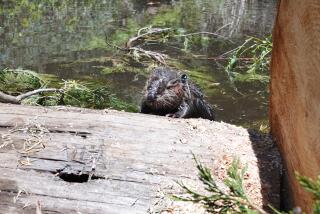Bison at Home on the Chilly Range
- Share via
Santa Catalina Island bison experienced wintry weather first-hand Thursday as they completed a 31-hour road trip and reached the open prairies of South Dakota.
The 104 bison -- commonly referred to as buffalo -- were unloaded at the Cheyenne River and Standing Rock Lakota Indian reservations in north-central South Dakota, ending a months-long effort by animal welfare advocates to transport them to the Northern Plains, where their ancestors lived.
“They’ve got thousands of acres to graze, and lots of hills, and good weather,” said Jamie Byrd, who runs a ranch with her husband, Casey, near the community of Ridgeview west of the Missouri River.
The Byrds received several dozen heifers and bulls and plan to use them as breeding stock to expand their herd.
Two large bulls balked as their truck was emptied Thursday, causing a four-hour delay, said George De Boer, owner of the trucking company that transported the animals.
One bull had to be led from a truck by tractor. Apparently frustrated by the long trip, it charged the tractor and punctured a tire at the Byrds’ ranch. The bulls calmed down when they joined their fellow bison at the ranch, Jamie Byrd said.
A Lakota tribal member performed a blessing ceremony for the animals Thursday morning, explaining that the bison’s spirit is part of the Lakota people, said Pauline Webb, editor of the Eagle Butte News.
The tribal member told onlookers that “when the buffalo come back, it brings great peace and harmony back to us,” Webb said.
The Catalina bison are descendants of 14 animals transported to the island in 1924 for the filming of a silent movie. Over the years, their numbers swelled to more than 300, straining food supplies and damaging native vegetation on the hilly island off Los Angeles County.
Since bison are not native to the 76-square-mile island, some biologists urged their removal, cautioning that they could help drive some native animals and plants toward extinction. But local businesses feared that losing the bison -- now a symbol of the island -- could harm tourism.
The Catalina Island Conservancy, which oversees 88% of the island, forged a compromise in which as many as 150 bison would be removed, and the remainder managed so as to prevent sharp population increases. A group called In Defense of Animals raised money to transport the bison to the Great Plains.
More to Read
Sign up for Essential California
The most important California stories and recommendations in your inbox every morning.
You may occasionally receive promotional content from the Los Angeles Times.













